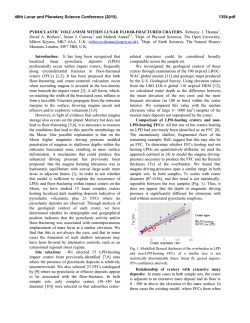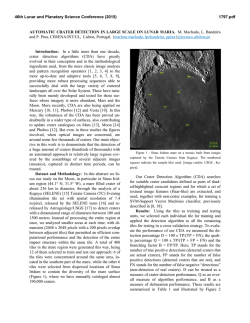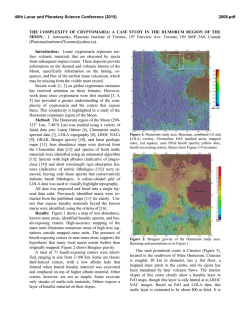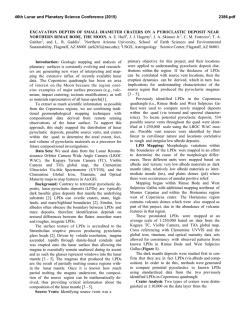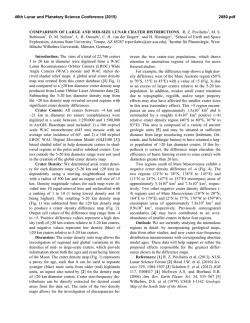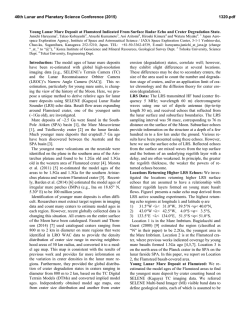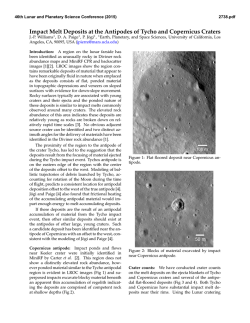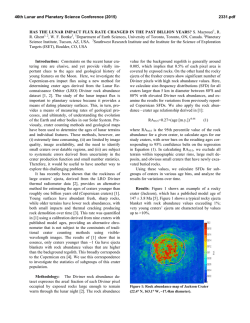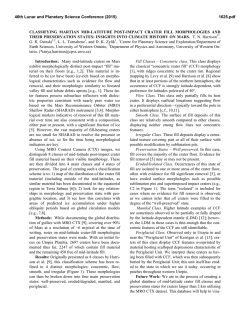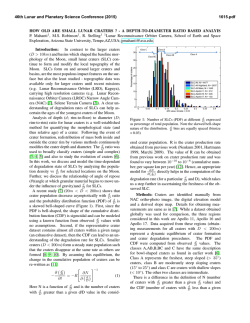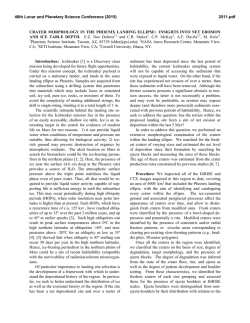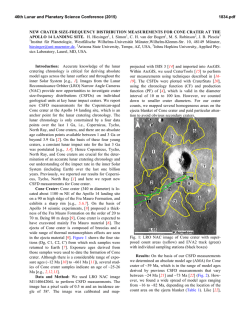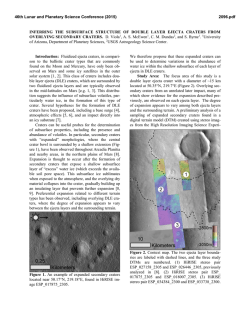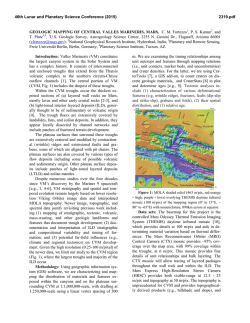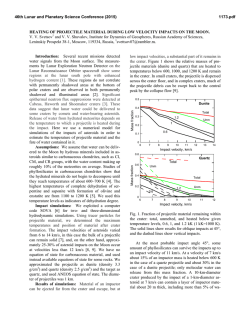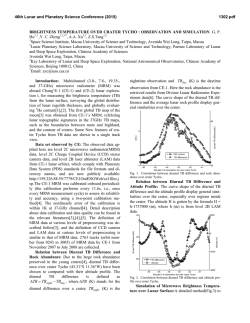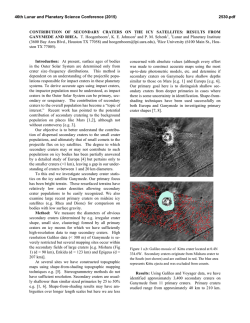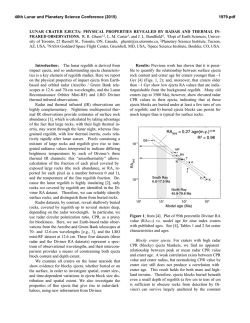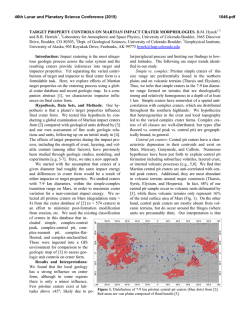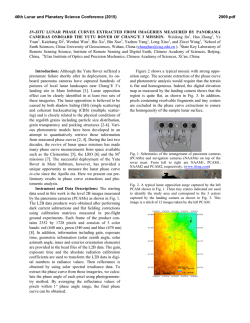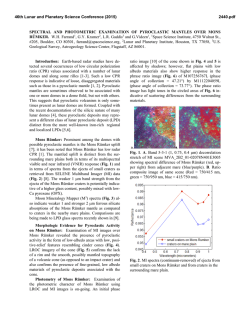
update on the geologic mapping of the lunar south pole quadrangle
46th Lunar and Planetary Science Conference (2015) 2510.pdf UPDATE ON THE GEOLOGIC MAPPING OF THE LUNAR SOUTH POLE QUADRANGLE (LQ-30): EVALUATING MARE, CRYPTOMARE AND IMPACT MELT DEPOSITS. S.C. Mest1, D.C. Berman1, N.E. Petro2, and R.A. Yingst1, 1Planetary Science Institute, 1700 E. Ft. Lowell, Suite 106, Tucson, AZ 85719-2395; 2 Planetary Geodynamics Laboratory, Code 698, NASA GSFC, Greenbelt, MD 20771. ([email protected]) Introduction: We are using recently acquired image, spectral, and topographic data to map the geology of the lunar South Pole quadrangle (LQ-30, 60°-90°S, 0°-±180°) at 1:2.5M scale [1-7]. The overall objective of this research is to constrain the geologic evolution of LQ-30 with specific emphasis on evaluation of a) the regional effects of impact basin formation, and b) the spatial distribution of ejecta, in particular resulting from formation of the South PoleAitken (SPA) basin and other large basins. Key scientific objectives for this map area include: 1) Determining the geologic history of LQ-30 and examining the spatial and temporal variability of geologic processes. 2) Evaluating the distribution of volcanic materials. And 3) constraining the distribution of impact-generated materials, and determining the timing and effects of major basin-forming impacts on crustal structure and stratigraphy. Methodology: This project utilizes ArcGIS (v. 10.1) to compile and integrate image, topographic and spectral datasets to produce a geologic map of LQ-30. The study uses the Lunar Reconnaissance Orbiter (LRO) Wide Angle Camera (WAC) mosaic (~100 m/pixel) as its primary base to characterize geologic units from surface textures and albedo, identify contacts and structures, and map impact craters (D>1 km). Additional datasets are being used to complement the base and include mosaics (Lunar Orbiter, Clementine UVVIS and NIR), images (LROC NAC, Clementine UVVIS and HIRES, and Lunar Orbiter), Clementine color ratio data, Moon Mineralogy Mapper (M3) multispectral data, and LOLA topography. Regional Geology: LQ-30 exhibits ~16 km of relief. The Near Side consists predominantly of cratered highlands, is more heavily cratered and displays higher elevations than the Far Side. This difference is due to the overwhelming presence of SPA, which encompasses nearly all of the far side map area (Figure 1). SPA is the largest (D=2600 km, ~18 km deep) and oldest (pre-Nectarian) impact basin confidently identified on the Moon [8-10]. Models suggest that SPA formed by an oblique impact that excavated material from the upper crust [11,12] to the lower crust or upper mantle [13,14]. Numerous multispectral datasets show enrichment in mafic materials [15-19] and LP-GRS data show enhancements in both Fe and Th [20-23] within the basin relative to the surrounding highlands. The materials exposed within SPA, such as in central peaks or in crater walls, are used to estimate the composition of the lower crust/upper mantle. Mapping Progress: We are currently focusing our mapping efforts on the floors of impact basins and craters and within portions of the intercrater plains that exhibit relatively flat surfaces in order to characterize the nature of these materials using image, spectral and topographic datasets. LQ-30 hosts all or part of 46 impact features greater than 100 km in diameter, craters that would have significantly affected the structure of the crust and redistributed large amounts of material across the surface [7]. Impact craters display morphologies ranging from simple to complex [7-9,24] and most contain floor deposits distinct from surrounding materials. Most of these deposits, especially for craters less than ~50 km in diameter, display moderate to bright floor materials with little to no surface expression; these materials likely consist of impact melt, possibly mantled by ejecta from nearby craters, that has been wellgardened. These higher albedo deposits also tend to contain a higher density of superposed impact craters. Mare Deposits: Most deposits on crater and basin floors exhibit moderate to low albedos with relatively smooth surfaces. Potential mare deposits are found on the floors of several of the larger impact craters (e.g., Antoniadi, Hausen, Klaproth, Moretus, and Amundsen) and basins (e.g., Schrodinger, Bally, Poincare, Planck, and Australe) within the map area [e.g., 6-9,25-27]. Although some deposits may be mantled by ejecta from younger impact events, the lower albedo of these materials, as well as their association with other features such as floor fracturing, dome-shaped or conical features suggests a volcanic origin. For example, volcanic materials within Schrödinger are concentrated inside the basin’s peak ring, display a smooth, featureless, low albedo surface, and are more mafic relative to other Schrödinger plains materials [6]. In addition, a sinuous rille is observed in association with the mare [5-7]. Schrödinger also contains a small (D=5 km) well-preserved ovoidal cone in the eastern part of the basin, just inside the peak ring. The cone displays ~500 m of relief above the surrounding plains and is ~400 m deep from its floor to its rim [6]. The cone has been characterized as a "maar" crater [25] and a "dark-halo crater" (DHC) [26], and has been identified as the source of pyroclastic eruptions [25,26]. Antoniadi Crater: Antoniadi crater (D=150 km; 69.5°S, 172°W) is unique on the Moon in that it is the only lunar crater that contains both a peak ring and a central peak, placing it morphologically between impact craters and multi-ring basins [8,9]. It contains the lowest elevations on the Moon (-8.5 km), which may provide access to lower crustal/upper mantle materials via its central peak and peak ring. Its floor deposits consist of 46th Lunar and Planetary Science Conference (2015) dark smooth material near the center of the crater, and brighter more rugged material between the peak ring and crater wall [7,28]. Recent mapping shows that the dark material embays the rugged material, as well as the peak ring and central peak. The rugged material likely includes impact melt. Superposition relationships indicate the dark material was emplaced after the rugged material and may consist of mare [7]. Mare Australe: Mare deposits are found on the floor of the proposed Australe basin along the eastern limb near the northern edge of the map area (~62°S, 90°E). These deposits are dark and smooth in appearance, but some are brighter and more rugged suggesting they are older and have been modified since their emplacement by (1) mantling by ejecta, (2) mixing by subsequent impacts, and/or (3) gardening and regolith development [7,8]. Intercrater plains: Several areas of intercrater plains also exhibit similar morphologic characteristics as crater- and basin-filling materials, such as moderate to low albedo, and relatively smooth surfaces. The origins of these materials are more difficult to determine due to burial by ejecta from nearby impacts, but we are analyzing the medium-resolution LROC WAC and high-resolution LROC NAC images, as well as M3 spectral data to evaluate the origin these materials. 2510.pdf References: [1] Mest, S.C. (2007) LPSC XXXVIII, #1842. [2] Van Arsdall, L.E. and S.C. Mest (2008) LPSC XXXIX, #1706. [3] Mest, S.C. and L.E. Van Arsdall (2008) NLSI LSC, NASA ARC, #2089. [4] Mest, S.C. (2008) GSA Joint Annual Mtg., #324-3. [5] Mest, S.C. (2009) Ann. Mtg. of Planet. Geol. Mappers, San Antonio, TX. [6] Mest, S.C. (2010) GSA Sp. Paper 447, SPE477-04. [7] Mest, S.C. et al. (2010) LPSC XLI, #2363. [8] Wilhelms, D.E. et al. (1979) USGS MISM I1162, 1:5M scale. [9] Wilhems, D.E (1987) USGS Prof. Pap. 1348. [10] Spudis, P.D. et al. (1994) Science, 266, 1848-1851. [11] Schultz, P.H. (1997) LPSC, XXVII, #1259. [12] Schultz, P.H. (2007) LPSC, XXXVIII, #1839. [13] Melosh, H.J. (1989) Impact Cratering, 245 pp. [14] Cintala, M.J. and R.A.F. Grieve (1998) Met. and Planet. Sci., 33, 889-912. [15] Belton, M.J.S. et al. (1992) Science, 255, 570-576. [16] Head, J.W. et al. (1993) JGR, 98, 17,149-17,182. [17] Lucey, P.G. et al. (1998) JGR, 103, 3701-3708. [18] Pieters, C.M. et al. (1997) GRL, 24, 1903-1906. [19] Pieters, C.M. et al. (2001) JGR, 106, 28,001-28,022. [20] Lawrence, D.J. et al. (1998) Science, 281, 1484-1489. [21] Lawrence, D.J. et al. (2002) New Views of the Moon, Europe, 12-14. [22] Lawrence, D.J. et al. (2002) JGR, 107, doi:10.1029/200lJE001530. [23] Jolliff, B.L. et al. (2000) JGR, 105, 4197-4216. [24] Wood, C.A. and L. Andersson (1978) Proc. Lunar Planet. Sci. Conf., 9th, 36693689. [25] Shoemaker, E.M. et al. (1994) Science, 266, 18511854. [26] Gaddis, L.R et al. (2003) Icarus, 161, 262-280. [27] Kramer, G.Y., et al. (2013) Icarus, 131-148. [28] Dominov, E. and S.C. Mest (2009) LPSC, XL, #1460. Figure 1. Geologic map of the lunar south pole quadrangle, LQ-30.
© Copyright 2025
